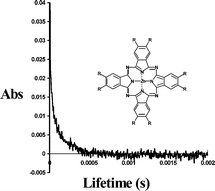Photophysical and photochemical studies of zinc(ii) phthalocyanine derivatives—effects of substituents and solvents
Abstract
The effects of substituents and

* Corresponding authors
a
Department of Chemistry, Rhodes University, Grahamstown, South Africa
E-mail:
t.nyokong@ru.ac.za
Fax: +27 46 6225109
Tel: +27 46 6038260
b State Key Laboratory for Advanced Photonic Materials and Devices, Department of Physics, Fudan University, Shanghai, P. R. China
The effects of substituents and

 Please wait while we load your content...
Something went wrong. Try again?
Please wait while we load your content...
Something went wrong. Try again?
A. Ogunsipe, J. Chen and T. Nyokong, New J. Chem., 2004, 28, 822 DOI: 10.1039/B315319C
To request permission to reproduce material from this article, please go to the Copyright Clearance Center request page.
If you are an author contributing to an RSC publication, you do not need to request permission provided correct acknowledgement is given.
If you are the author of this article, you do not need to request permission to reproduce figures and diagrams provided correct acknowledgement is given. If you want to reproduce the whole article in a third-party publication (excluding your thesis/dissertation for which permission is not required) please go to the Copyright Clearance Center request page.
Read more about how to correctly acknowledge RSC content.
 Fetching data from CrossRef.
Fetching data from CrossRef.
This may take some time to load.
Loading related content
